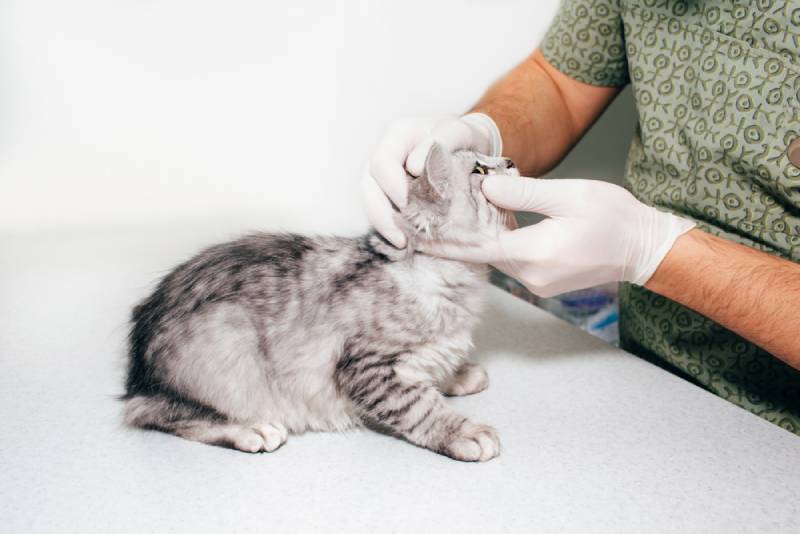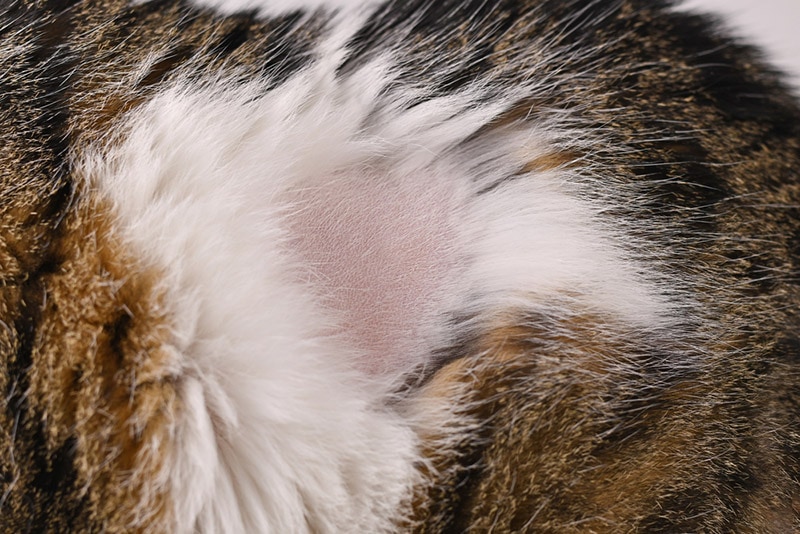My Cat Has a Bald Spot Above Their Eye: Should I Be Worried? Vet-Approved Causes & Care Tips
Updated on

Click to Skip Ahead
Cats are mysterious and have reclusive tendencies that make it hard to tell when something’s wrong with them. When you notice that your cat has a strange bald patch on their head or above their eye, it’s understandably alarming. Balding fur between the ears and eyes might even have underlying skin that appears red, chapped, or scaly, which can drive your cat up the wall. A quick trip to the vet can shed some light on the exact triggers causing the rash. They’ll assess the severity and recommend a course of action, whether it’s a medicated ointment, medicated bath, or antihistamines.
If you’re interested in learning more about how to manage your cat’s balding fur, some potential causes of balding fur above the eyes, and a few ways to keep their coat and skin healthy, stick around. All that info is right below to help you tackle this worrying condition.
Causes of Bald Spots in Cats
Sparse fur between the eye and ear is normal for many cats. If your cat has always been this way, it’s unlikely to be a cause for concern. However, if it’s new, skin parasites such as fleas, allergies, and other skin conditions might be to blame.. In a lot of cases, it’s even a combination of them! Let’s learn about how these relate to balding cat fur in more depth.
Fleas & Other Bug Infestations

Severe fleas and other parasitic infestations can cause bald patches on your cat’s fur because they furiously lick and scratch the afflicted area. If you notice visible signs of a parasite infestation on your cat’s coat, take them to a vet as soon as possible. They can diagnose how serious the case is and advise you on the best course of action.
Stress/Pain
Stress-induced overgrooming is sadly common. Affected cats will excessively lick themselves as a self-soothing mechanism, causing fur loss in the areas groomed most. This usually resolves with time, but you can help by getting your cat a checkup to check if they could be suffering from pain somewhere in their body. In the case of stress, the best way to help is to identify the trigger, remove it, and give them a safe place to relax.
Medications

Some medication may cause slowed or poor hair turnover, meaning that these cats’ haircoats can become thin, and lackluster. A common medication that can contribute to this is a corticosteroid. The longer a cat takes this medication, the more likely adverse effects such as balding or hair thinning will be seen. Unfortunately, there’s not much you can do about this form of balding, but speak to your vet if you suspect this may be occurring.
Allergies
Skin allergies can occur in cats for a variety of reasons. Itching can be a result of these allergies, which can lead to hair loss, red skin, and associated scabbing, amongst other signs. Allergies need to be assessed by a veterinarian, as many other skin conditions can mimic this skin condition. One of the most common forms of skin allergies in cats, other than fleas, is food. Therefore, bring a list of the things your cat is eating, such as the brands and flavors of foods, and treats, with you to your vet visit, as this can help your vet identify any potential triggers.
What Should I Do if My Cat’s Balding Fur Is Worsening?
Mild bald patches can be normal as long as the skin or surrounding fur isn’t red, irritated, or rapidly losing fur. We urge you to take your cat to a qualified vet who can perform tests to diagnose the exact cause(s) of your cat’s fur problem. In addition to a list of your cat’s foods, bring information on any medications your cat is taking, including flea and parasite treatments.

Tips for Keeping Your Cat’s Fur Healthy
Everyone knows that cats are neat freaks when it comes to their fur, but sometimes they need a little help to keep it in good condition and clean. Not all cats tolerate baths well, but most are cool with being brushed every now and then. If you really want to keep your cat’s fur healthy and sleek for a long time, consider adopting some of the tips below into your grooming routine.
- Start grooming early in kittenhood, as it will help them calmly accept grooming later in life.
- Groom with a soft brush to remove dead fur and redistribute skin oils throughout the fur, reducing the chances of skin infections and promoting healthy skin blood flow.
- Long-haired breeds like the Siberian might need to be brushed twice a week, while you can get away with weekly grooming sessions with short-haired breeds.
- To deal with knots, consider a steel grooming comb to unpick mats. However, mats are usually best dealt with by a professional groomer.
- Baths should be rare and primarily in case a problem liquid gets spilled on your cat’s fur. In these cases, only use shampoo formulated specifically for cats.
Conclusion
It’s normal for some cats to bald between the eyes when they’re older, or even to be born with less fur in the area to begin with. However, in some cases, it’s caused by allergies, stress, pain, or skin parasites. If you notice any change in your cat’s behavior or appearance, you should make an appointment with your vet.
Featured Image Credit: Azovsky, Shutterstock














